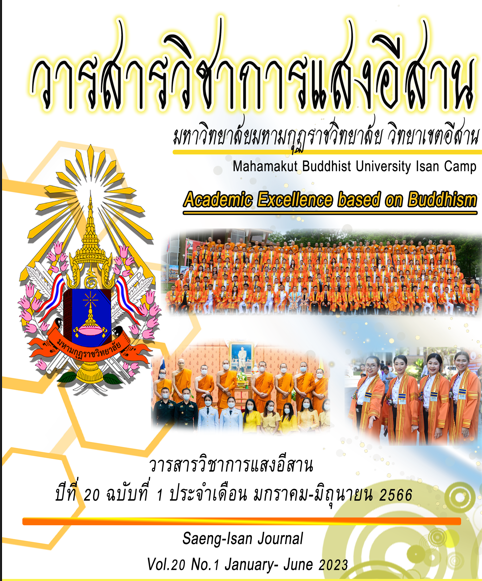การเสริมทักษะการอ่านภาษาอังกฤษเพื่อความเข้าใจโดยใช้ หนังสือประวัติศาสตร์พุทธศาสนา
บทคัดย่อ
การวิจัยครั้งนี้มีวัตถุประสงค์ (1) เพื่อศึกษาเปรียบเทียบการเสริมทักษะการอ่านภาษาอังกฤษเพื่อความเข้าใจโดยใช้หนังสือประวัติศาสตร์พุทธศาสนา ก่อนและหลังเรียน (2) เพื่อศึกษาดัชนีประสิทธิผลการเสริมทักษะการอ่านภาษาอังกฤษเพื่อความเข้าใจโดยใช้หนังสือประวัติศาสตร์พุทธศาสนา และ (3) เพื่อศึกษาความพึงพอใจในการเสริมทักษะการอ่านภาษาอังกฤษเพื่อความเข้าใจโดยใช้หนังสือประวัติศาสตร์พุทธศาสนา ผู้ร่วมวิจัยครั้งนี้ คือนักศึกษาชั้นปีที่ 1 สาขาวิชาการสอนภาษาอังกฤษ คณะศึกษาศาสตร์ มหาวิทยาลัยมหามกุฏราชวิทยาลัย วิทยาเขตอีสาน จำนวน 30 คน ที่ได้มาโดยวิธีการเลือกแบบเจาะจง ระยะเวลาในการทดลองทั้งหมด 10 สัปดาห์ สัปดาห์ 3 ชั่วโมง เครื่องมือที่ใช้ในการเก็บรวบรวมข้อมูล ได้แก่ แบบทดสอบการอ่านเพื่อความเข้าใจ และแบบวัดความพึงพอใจ สถิติที่ใช้ในการวิเคราะห์ข้อมูลได้แก่ ค่าเฉลี่ย ร้อยละ ส่วนเบี่ยงเบนมาตรฐาน และการทดสอบแบบที่ไม่เป็นอิสระต่อกัน ( T-test Dependent)
ผลการวิจัยด้านการเสริมทักษะการอ่านภาษาอังกฤษเพื่อความเข้าใจของนักศึกษาโดยใช้หนังสือประวัติศาสตร์พุทธศาสนา พบว่า นักศึกษามีทักษะการอ่านภาษาอังกฤษเพื่อความเข้าใจโดยมีคะแนนเฉลี่ยก่อนเรียนเท่ากับ (μ =11.60, =3.29) คิดเป็นร้อยละ 38.66 และคะแนนเฉลี่ยหลังเรียนเท่ากับ (μ =21.73, =2.93) คิดเป็นร้อยละ 72.44 ซึ่งสูงกว่าเกณฑ์ร้อยละ 70 ผลการศึกษา พบว่า ทักษะการอ่านภาษาอังกฤษเพื่อความเข้าของนักเรียนเพิ่มขึ้นอย่างมีนัยสำคัญทางสถิติที่ระดับ 0.05 ด้านการศึกษาความพึงพอใจต่อการสอนอ่านภาษาอังกฤษเพื่อความเข้าใจโดยใช้หนังสือประวัติศาสตร์พระพุทธศาสนา พบว่านักศึกษามีความพึงพอใจต่อในระดับมาก (μ =4.51, =0.64) นอกจากนี้ การใช้หนังสือประวัติศาสตร์พระพุทธศาสนาเพื่อเสริมทักษะการอ่านเพื่อความเข้าใจของนักเรียนส่งผลดีต่อความรู้คำศัพท์และความรู้ด้านไวยากรณ์ของนักเรียนตลอดจนความรู้ด้านเนื้อหาในพระพุทธศาสนา
เอกสารอ้างอิง
Anderson, N. J. (1999). Exploring second language reading: Issues and strategies. Heinle & Heinle Publishers.
Anderson, R. C. (1985). Role of Reader’s Schema in Comprehension, Learning, and Memory. In Theoretical Models and Process of Reading, Edited by Rebert and Ruddle. Newark, Delaware: International Reading Association.
Brown, H.D. (2001). Teaching by principle: an interactive approach to language pedagogy. (2nd Eds). NY: Pearson Education.
Chiappe, P., Siegal, L., Gottardo, A. (2002). Reading-related skills of kindergarteners from diverse linguistic backgrounds. Applied Psycholinguistics, (20),95-116.
Cobb, T. (2007). Computing the Vocabulary Demands of L2 Reading: Language Learning & Technology. London: Education Center Ltd.
Finocchiaro, M. and Sako, S. (1983). Foreign Language Testing: A Practical Approach. New York: Regents.
Ganschow, L., Sparks, R. L., Anderson, R., Javorshy, J., Skinner, S., & Patton, J. (1994). Differences in language performance among high-, average-, and low-anxious college foreign language learners. The Modern Language Journal, 78(1), 41-55.
Grabe, W. & Stoller, F. L. (2002). Teaching and Researching Reading. Harlow:
Pearson.
Grabe, W. (2009). Reading in a second language: Moving from theory to practice. Cambridge: Cambridge University Press. Pearson.
Harmer, Jeremy. (2001). The Practice of English Language Teaching. (3rd eds.). China: Longman.
Harris, L. A. & Smith, C. B. (1980). Reading Instruction. New York: Holt, Rinehart and Winston.
Harris, Albert. J. & Edward R. Sipay (1979). How to Teach Reading. New York: Longman Inc. Toward Learner Autonomy. Boston: Heinle and Heinle Publishers.
Harris, L. and Smith, C. (1976). Reading instruction. New York: Richard C. Owen Publishers, Inc.
Krashen, S. (1989). We acquire vocabulary and spelling by reading: Additional evidence for the input hypothesis. Modern Language Journal, 73(4), 440–464.
Karahan, F. (2007). Language attitudes of Turkish students towards the English language and its use in Turkish context. Journal of Arts and Sciences, (7), 73-87.
Krashen, S. (1981) Second Language Acquisition and Second Language Learning. Pergamon Press, New York.
Sakthai, S. (2002). Social psychology. Bangkok: Suweeriyarsan.
Smith, F. (1985). Reading. (2nd eds.). London: Cambridge.
Stoller, F., & Grabe, W. (1993). Implications for L2 vocabulary acquisition and instruction from L1 vocabulary research. In T. Huckin, M. Haynes, & J. Coady (Eds.), Second language reading and vocabulary learning (pp. 24–45).
Visser, M. (2008). Learning under conditions of hierarchy and discipline: The case of the German Army (1939-1940). Learning Inquiry, (2), 127-137.
ดาวน์โหลด
เผยแพร่แล้ว
ฉบับ
ประเภทบทความ
สัญญาอนุญาต
ลิขสิทธิ์ (c) 2023 วารสารวิชาการแสงอีสาน

อนุญาตภายใต้เงื่อนไข Creative Commons Attribution-NonCommercial-NoDerivatives 4.0 International License.
เนื้อหาและข้อมูลในบทความที่ตีพิมพ์ในวารสาร ถือเป็นข้อคิดเห็นและความรับผิดชอบของผู้เชียนบทความโดยตรง ซึ่งวารสารไม่มีส่วนเกี่ยวข้อง นอกจากนั้น ผู้เขียนทุกท่านต้องยืนยันว่าบทความต้นฉบับที่ส่งมาตีพิมพ์เผยแพร่นั้น จะต้องไม่เป็นบทความที่กำลังอยู่ในการพิจารณาเพื่อตีพิมพ์ในวารสารอื่นหรือเคยตีพิมพ์เผยแพร่มาแล้ว หากมีการใช้ภาพ ข้อความหรือตารางของผู้เขียนหรือผู้นิพนธ์ท่านอื่น ผู้เขียนจะต้องอ้างแหล่งที่มาหรือเจ้าของลิขสิทธ์
Publication Ethic:
The detail published in Saeng Isan Journal is opinion and responsibility of the authors, and it is not relevant with the jouranl. Besides, the authors must certify that the original manuscript is not in the process to publish in other journals or used to publish in other journals. If the authors use paragraphs, pictures or tables from others, the athours must refer to the original sources.
Article Consideration:
Each article will be published by a panel three journalists with expertise in relevant fields, and get the editorial approval before publishing. The review is in the form of The article's double blind.
To comply with copyright law. The author must sign the copy of the article submission form to the journal. In addition, the author must confirm that the original article submitted to the journal is only one publication in Saeng Isan Journal. If the images or tables of other authors appearing in other publications are used, the author must ask permission of the copyright owner before publishing.


